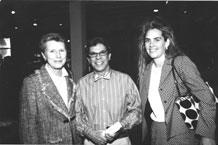Faculty of Fine Arts builds bridges to Europe

Artstravaganza night out raises $7,000. Seen enjoying Artstravaganza V at the Centaur Theatre are, left to right, Rae Heenan, Errol Periera, and Nikola Reford. The annual spring fundraising event for undergraduate scholarships in the Faculty of Fine Arts, raised $7,000 at on May 19 through a performance of Theatre Professor Kit Brennan’s play, Tiger’s Heart, and a silent auction of donated art works. Montreal critics loved the play. It had been produced in other cities, but this was its Montreal premiere.
Photo by Kathy MacCulloch
Liselyn Adams, Associate Dean (Research and Graduate Studies), has just returned from a trip to Europe, where she spread the good word about Concordia’s Faculty of Fine Arts and explored potential exchanges with art schools.
She visited two schools in Sweden, two in Germany and one in France. The trip, from April 17 to May 6, left her “dizzy” but exhilarated.
“We started to expand our international exchanges with a trip to China in 2002,” she said. “Both professors and students want to do more exchanges. They see the advantages of a wide choice of faculty and campuses for studies and research.
“Some schools are particularly interested in exchanges of teams of faculty and students, both academic researchers and artists, working along a theme such as public art or forms of narrative, for example.”
At Göteborg University, in Sweden, three of the three arts schools (Valand School of Fine Arts, the Design and Craft School, and the Photography and Film School) were interested in discussing exchange.
“While I was there we applied for a grant to fund a joint project on public and political art. We also discussed the possibility of Canadian fine arts Faculties joining the northern higher education network for the arts, KUNO. We are a Nordic country, after all, and the possibilities of short-term workshops, regular seminars, student and faculty exchange through the network are exciting.”
Adams also visited Götland University, in Visby, on the Swedish island of Götland. This is a small university in a medieval town on an island, and Adams said it is a growing school for media arts, gaming, and digital development in many areas.
“It was interesting to see the same tensions between the art historians and artists, and the technological orientation focused on gaming. It is a healthy tension, and they have some very strong artists and scholars on faculty there.
“They are very interested in teaching and research group exchanges to bring as many influences to their institution as possible, and to spend time at schools like Concordia. In conjunction with three local institutes — the Composers’ Institute (with one of the finest electroacoustic studios I have ever seen), the Baltic Arts Centre, and the Baltic Writers’ Association, all offering free residencies in excellent facilities — there is a great deal of encouragement of a wide variety of creation and scholarship.”
Concordia’s contact with Götland began through the administration of an annual prize given to a young artist from Canada and another from the Eureopean Union. The prize was established by the Brucebo Foundation in memory of Canadian painter William Blair Bruce. He was married to a Swedish artist, Carolina Benedicks, who established the foundation to support young artists.
Since Concordia took over the adjudication of the prize on the Canadian side, a connection has been made with the university. Several Concordia students and graduates have won the prize over the years, and spent a summer in a small cottage by the sea creating art in a beautiful setting.
In Germany, Adams visited Bremen University’s Digital Media Department (which is run across four institutions including the Fine Arts University) and the Bauhaus University in Weimar.
“We already have an agreement with Bremen, and were exploring ways of strengthening the ties. This summer we will work on a Canada-EU higher education consortium project involving six institutions. We will also be sending two professors from Digital Image and Sound to Bremen to teach workshops, PK Langshaw and Jason Lewis.
“In Weimar, the Faculties of Media and of Art and Design offer very interesting programs bridging many areas of common interest, including electroacoustic composition, digital media art in many forms, and public art. Their approach is vigorously conceptual and we would like to invite their Professor Wolfgang Kissel to be the first visitor, working on a project on media manifestation. Two or three students from each of these schools will be joining us in September.”
Adams’ last stop was in Nantes at the École Regionale de Beaux-Arts. “We have already had several student exchanges under CREPUQ programs, and hope to add on a short-term research/creation team project after signing a more comprehensive agreement.”
Adams finished her trip with several days days in Venice working on the organization of a conference inspired by 18th-century composer Antonio Vivaldi, who worked with orphaned children.